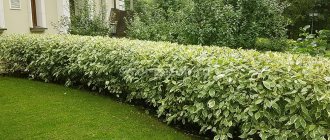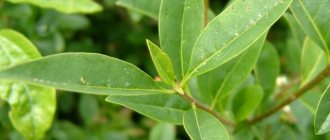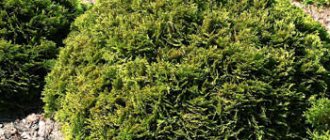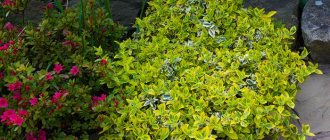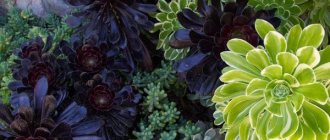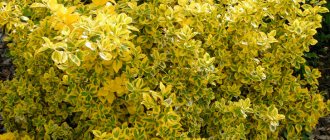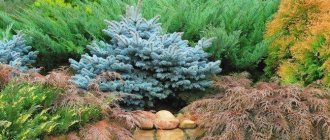Fortune's euonymus in landscape design
An infrequent visitor to our gardens is the euonymus fortunea.
This plant is undeservedly ignored by gardeners. The reason is the rare flowering of shrubs in the climate zone of our country. But professional landscape designers value the creeping evergreen bush for its amazingly beautiful leaf colors, original and unique. A kind of “zest” of the personal plot decorates it all year round. Content:
Fortune is a variegated variety of euonymus. The homeland of this representative of the flora is China. The low-growing plant reaches up to 2 meters in length and 50 cm in height. The shrub can take root in the soil when weaving, or cling to supports and curl upward. Hard, leathery, oval-shaped leaves, two colors, changing throughout the year. When giving preference to this plant in your garden, do not forget that it is poisonous. Especially the fruits.
Tips for planting and caring for hedges
To begin with, select a territory and clear the designated area of weeds. To ensure a tight planting, dig a trench. If the plants are located sparsely, then holes are made. The trench should be 50 cm wide and 60 cm deep.
Those bushes or trees that grow quickly are planted loosely, while slow-growing plants are planted more often. Bushes that will be trimmed in the future are planted at intervals of up to 60 cm, and free-growing ones up to 1 meter. After planting, new plants are carefully looked after: watered, loosened, weeded.
In the first year after planting, it is better not to prune. Plants need to get used to the new place and get stronger in order to survive the winter well. Shrubs or trees should be watered sparingly. Plants also need to be fed, but not overdo it.
In our garden center you can buy barberries for hedges and other plants presented in this article at affordable prices.
Application in landscape design
The main direction in transforming the territory of Fortune is as a ground cover plant. It is planted in large quantities, in dense groups on large tracts. Due to its good tolerance to urban air pollution, euonymus is used for landscaping parks, alleys and city squares. Beautiful decorative leaves that grow quickly will always help hide defects or communications.
If it is not possible to plant a real lawn, then fortune's euonymus will perfectly play its role. Also used by designers as hedges and borders. Thanks to the versatility of the plant, using it to improve the territory, you can solve several problems at the same time. By choosing the right lighting for your site, you can realize the most fantastic ideas.
A pleasant feature of the shrub is the formation of a dense covering and blocking the growth of weeds. Thanks to this property, the bush is planted in those areas that have an important functional purpose. The plant will highlight this area and allow it to always have a well-groomed appearance. The gardener only needs proper cultivation and minimal costs for caring for the plant are ensured.
Need to create a colorful border in front of a building or a luxurious rock garden? Euonymus Fortune is ideal for these purposes. The evergreen shrub gives a well-groomed and cultivated appearance to any composition. Especially after the snow melts. With euonymus, the garden seems to come to life. Multi-colored foliage has always been rightfully valued by designers and gardeners. By creating a composition of plants that bloom at different times of the year, Fortune becomes an excellent backdrop for each of them. Combining seemingly incompatible plants into a single ensemble.
In an ensemble in which relief and color need to be emphasized, the choice of gardeners is definitely luck. The shrub also takes part in shaping the style of the garden. It will become a harmonious object of Provence, rustic, English and other styles. The plant has an amazing ability to emphasize the aristocracy or simplicity of the composition, depending on its purpose.
Styling
Landscape style
Imitating the natural environment of plants without human intervention, it uses euonymus as a solo-composite plant. It is planted near wooden benches, artificial ponds and fountains, gazebos, and along paths. By following a certain plan when planting Fortune and taking into account its properties, you can get a shrub along the path or one of the plants forming a bosquet.
French style
Requiring perfect haircut and symmetry, it provides places for Fortune near axial compositions (fountains, large trees, sculptures, etc.). Symmetrically located euonymus bushes acquire a solemn and aristocratic appearance. Flowerbeds are created taking into account their flowering period, for an unusual pattern. Despite the fact that the euonymus acts as a background to them, its color is taken into account first of all. Acting as a contrast to this or that flower, it plays the role of an accent in the flower garden.
Chaotic at first glance Scandinavian style is just the first impression
In fact, each plant and decorative item has a clearly thought out place. For Fortune, among other things. It grows near garden furniture, arbors and stone steps. If large hewn logs are used instead of benches, then euonymus envelops them, making up a single composition.
Russian manor style, more practical
Euonymus is assigned certain aesthetic zones. Such as paths and bright, lush flower beds at the entrance to the garden or vegetable garden. Fortune plays a supporting role during the warm seasons, and plays a major role in winter. To give the area a “careless” look, the plant is rarely trimmed. It is allowed to entwine bushes with low fences dividing the garden into working areas.
Japanese style
Euonymus is planted, at first glance, not thought out and in different ways. Following all the rules and requirements of style. But in reality, he is assigned several zones and one or two smooth transitions into them. Emphasizing the superiority of nature over people, fortune grows near the entrance to a garden or house, near a gazebo and ponds.
Combination with other plants
Flowering phlox, deciduous perennials and paniculata will make good company for euonymus in an alpine hill or rock garden. Low-growing Cossack or horizontal juniper will highlight the bright decorative foliage of Fortune in the rock garden.
Dwarf shrubs such as barberry, periwinkle, spirea and others are combined with euonymus in the center of the site. It hides the trunk of shrubs and creates the effect of a lush composition.
Combining shrubs with representatives of pine needles will be beautiful at any time of the year. Thuja, juniper, boxwoods are just part of the list of compatible plants. Emerald foliage with a golden border will highlight the shade of pine needles and will become an unrivaled decorative element in the garden.
Rhododendrons lemon light and mandarin light bloom simultaneously with euonymus, and the combination of their inflorescences (lemon yellow, orange-red and yellow with green) complement each other and create a warm spring mood.
Tree peony, hydrangea, and euonymus are a win-win option for a flower bed along the path. Not only flowers, but also beautiful decorative leaves delight the eye and continue to create an elegant landscape even after flowering. Planted in color tiers.
Planting, care and diseases
Planting time: spring or autumn . Loamy soil can create the most favorable conditions for growth and development. Optimal lighting is sun, slight shade. Does not like stagnant water in the soil. A drainage layer (gravel, expanded clay, sand, peat) is laid out in the hole before planting. The depth of the hole is 30 cm, the root ball should remain above the ground, at least 5 cm. After planting, water generously. Mulch the area around the trunk using a layer of earth or wood chips. Fertilize in spring or autumn, once a year.
The plant needs watering during dry summers and early spring. Young seedlings systematically, adult plants as needed - once every 5 days. A young plant must be protected from weeds; in the first 2 years it cannot cope on its own. 2-3 days after watering, the soil is loosened. For the winter, sensitive young shrubs (dry foliage) are covered. By planting a shrub in an area without drafts, in winter it will be provided with natural shelter from frost - snow.
The bush is not painful . The most dangerous pests for it are aphids, spider mites, euonymus scale insects, and fungal diseases.
They lead the plant to deformation and possible death. To combat and prevent them, the plant is sprayed with a solution of chemicals. The drug Actellik is used once every 7 days for three weeks to control pests. Concentration is 1 ml of the drug per 1 liter of water. For prevention, once a year - in the spring, 1 ml of the drug per 2 liters of water.
Technology and timing of planting euonymus in the garden
Before planning to grow shrubs in your summer cottage, read the descriptions of the species of this plant. So, in the Moscow region, cold-resistant euonymuses do well:
- winged;
- Fortune;
- European;
- warty.
Also read: Blueberries: rules of care in the fall and features of preparation for winter
Depending on the climate, euonymus is planted in autumn or early spring. So, in the middle zone it is advisable to do this in April, but residents of the south of the country will be able to choose autumn planting without fear. The seedling needs some time to strengthen its root system and cope with the cold. The shrub prefers shaded places; the soil should be fertile and loose. Too acidic soil is improved by adding slaked lime or dolomite flour.
It is important to know that euonymus does not tolerate stagnation of water in the ground, which is why areas with a high level of groundwater are not suitable for planting a bush. A hole for the plant is dug 2 weeks before gardening; its size directly depends on the volume of the root system of the seedling.
Description of Fortune's euonymus
Fortune's euonymus (Euonymus fortunei) is an evergreen bush that grows like a grape vine using support. The leaves are elliptical, ovoid, pointed, their width is up to 3 centimeters and their length is up to 6 cm. The color of the leaves depends on the variety, ranging from green to raspberry-pinkish. The culture withstands frosty temperatures well. The height of the bush is up to 0.6 meters, and the side shoots can develop up to 3 meters. Thanks to the rich fruits that form on the plant, it becomes even more vibrant and original.
Features of growing euonymus (video)
Japanese euonymus
The plant, which is believed to be native to Eurasia, is famous for its pointed, dark green leaves that have a light edge and are colorful. The bush is directed upward, its foliage is dense, and the height of exceptional specimens reaches 150 cm. Japanese euonymus (Euonymus japonicas Microphyllus) in June, from 15 to 30 flowers are formed on each bush.
The temperature for growing the plant must exceed 5 °C, so it is cultivated in greenhouses and houses; in the summer, the bush is taken out into the fresh air and used to decorate the area.
Japanese euonymus
European euonymus
This deciduous shrub has an openwork crown, and its height can reach 2 meters or more. The elliptical leaves are green in summer; small flowers with brownish petals can be seen at the end of May. In autumn, European euonymus (Euonymus Europaeus) becomes very colorful - the foliage takes on a reddish hue. The fruits remain on the tree almost all winter, decorating the empty area.
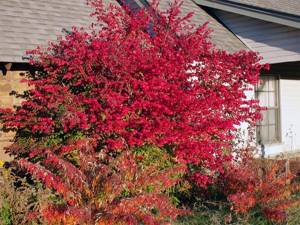
European euonymus
Euonymus winged
This plant comes from Southeast Asia, it is characterized by a wide and spreading crown, which grows by 15 cm every year. The bush looks impressive, and its height in nature can reach more than 2 meters, while ornamental gardening requires a small size of euonymus. The leaves of the bush are dense and shiny without hairs. It blooms in early June , during this period greenish flowers appear on the plant, then they become fruits. In autumn, the shrub delights gardeners with purple and red shades of foliage.
Also read: Variety of types of jasmine

Euonymus winged
Euonymus variegated
Gardeners note the popularity and colorfulness of the plant variety “Emerald in Gold”. It is miniature, the height of most specimens does not exceed 40 cm. The leaves are ovoid, painted in green, golden and yellow tones. In autumn, the variegated euonymus acquires a reddish-brown color and is used in many summer cottage compositions.
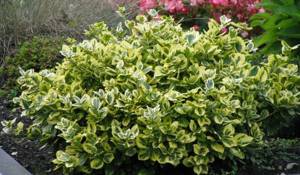
Euonymus variegated
Euonymus warty
This species does not stand out in height; the height of old specimens does not exceed 2 meters. In general, such plants can be called slow-growing, long-livers - the age of some shrubs in greenhouses reaches 40 years. Young shoots of the described euonymus are greenish-brown, but over time the bark turns black. In mid-May, the branches of the bush are covered with flowers, the smell comes from them unpleasant, and the pollinators of this species are flies.
In autumn, the leaves of the warty euonymus turn purple, pink or burgundy, and ripe carmine-colored fruits containing black seeds complement the natural spectacle.
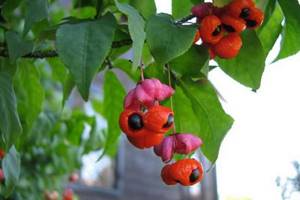
Euonymus warty
Euonymus Fortune
The evergreen deciduous plant is cold-resistant due to the peculiarities of the location of the shoots - they spread above the soil surface and are covered with snow, protecting the bush from frost. This euonymus has leathery leaves with curved edges, and their color varies depending on the variety.
For example, the variety "Emerald Gaiety" is green with a white border in summer, and the foliage turns pinkish in autumn. There are also varieties with a white leaf border, yellow spots in the middle and dark green specimens. Despite the variety of shades, all plants retain the characteristic glossy shine of their leaves, and they rarely reach 60 cm in height, remaining miniature shrubs. Inconspicuous and small flowers appear in June, then they are replaced by fruits, giving Fortune's euonymus a decorative appearance.
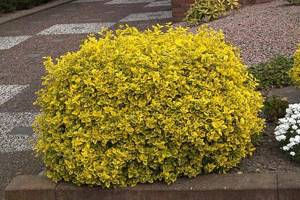
Euonymus Fortune
Euonymus dwarf evergreen
In areas of China with a warm climate and similar parts of our country, dwarf euonymus is cultivated. Its height rarely exceeds 1 meter, and its creeping shape thanks to long shoots makes this shrub especially beautiful. Narrow lanceolate leaves reach a length of 4 cm, very small flowers are held on purple peduncles. This euonymus forms picturesque clumps and is able to grow on poor soil in the shade of tall bushes.

Euonymus dwarf evergreen
Fortune euonymus shrub: rules of planting and care
Shrubs prefer sunny areas, but without direct ultraviolet rays. Therefore, slightly shaded areas are the ideal solution. For planting, it is recommended to buy 3-year-old seedlings with a good root system. It is better to plant in the spring after the soil has warmed up; the optimal period is considered to be the end of April - the beginning of May. The soil chosen is aerated with neutral acidity. You can even prepare the composition yourself. For this, leaf and turf soil, humus, and sand are used (percentage ratio - 50 to 10 to 30 to 10%).
Choose a hole for planting that is 2 times larger than the rhizome. Pre-compact the bottom, lay a drainage layer consisting of expanded clay and pebbles. After planting, be sure to water the bush generously, then sprinkle with a layer of soil.
The Fortune variety is not demanding in care. During dry summers, additional watering of the plants will be necessary. 1 m² will require 30 liters of water. The crop responds well to fertilizers. To do this, use bone meal or bird droppings. Potassium salt or superphosphate fertilizers (10 and 30 g, respectively) are added to the circle around the trunk.
Damaged branches are removed in the spring, after which the cut areas are treated with garden varnish. Cover young bushes for the winter using spruce branches or straw.
Shrub propagation rules
The shrub is propagated by all available methods - seed, dividing the bush, cuttings or layering. But the last two methods are the most effective. For cuttings, bushes that are more than 5 years old are suitable; form planting material 8-12 cm long. The cut must be treated with “Kornevin”, then rooted in the prepared soil. During this period, do not forget to provide moderate watering of the seedlings.
To propagate by layering you will need to do the following:
- choose a low-growing shoot on a bush;
- form a hole under it;
- strengthen the branches there, sprinkle them with soil;
- Water regularly and abundantly.
After some time, roots will appear on the seedling, after which the cuttings are transplanted to the right place.
Euonymus propagation
Most types of euonymus reproduce well vegetatively: by dividing the bush, root suckers, and green cuttings. For the latter, in June-July, young but already quite elastic shoots are chosen. Cuttings 4-6 cm long with one internode are cut from them. They are planted in a greenhouse under a film in a substrate of fertile soil, on top of which sand is poured in a layer of 5-7 cm. The roots develop in 1.5 months.
Seed propagation of euonymus is somewhat more complicated. When sowing without stratification and in nature, the bulk of seeds germinate only in the second spring. Therefore, immediately after collection, euonymus seeds should be stratified, for which they are mixed with coarse calcined sand or slightly decomposed moistened sphagnum peat in a ratio of 1:2. Stratification takes place in two stages. First, euonymus seeds are kept at a temperature of 10-12ºC for 3-4 months. When the majority (70-80%) of the shell bursts, the temperature is reduced to 0-plus 3 and stored in such conditions for another 4-5 months. To prevent rotting, before planting, the seeds should be cleared of their arils and pickled in a 0.5% solution of potassium permanganate.
Sow on beds in shallow (about 2 cm) furrows in a substrate of leaf and turf soil, humus and sand in a ratio of 4:1:2:1. Shoots appear in 2-3 weeks. In spring and autumn, it is recommended to mulch euonymus seedlings with peat chips in a layer of 3 cm. During the summer, the plants are watered and fed with mullein, and covered with spruce branches for the winter. In the 3rd year they are transferred to a permanent place.
Varietal diversity of shrubs
The efforts of the breeders were not in vain, so now you can select many variants of this variety for planting. Let's look at the most popular:
- Euonymus Fortune Emerald'n Gold . Low bush - up to 0.6 meters. It is distinguished by leaves with a golden frame; by autumn they turn into a bright pink color. For the winter, the bush does not require shelter.
- Vegetus . The bush is distinguished by its miniature forms - up to 0.15 meters. The leaves are a rich green shade with white veins; in our regions it can winter without shelter, but in severe winters it is better to insulate the plant with spruce branches.
- Canadale Gold . The leaves have a yellow border, the bushes are compact, quickly develop, reaching up to 0.6-0.8 meters in width.
- Euonymus Fortune Harlequin . A dwarf variety with variegated white leaves with pink, cream and yellow splashes. It is considered an excellent ground cover for growing in shaded areas. The height of the crop is up to 1.4 meters, width is 100 cm.
European euonymus
Place of growth - the territory of Western Europe and Asia Minor. The European euonymus tree can reach a height of 6 m. It usually grows as a bush.
Old branches have a black tint, while young ones are green and sometimes decorated with longitudinal cork growths.
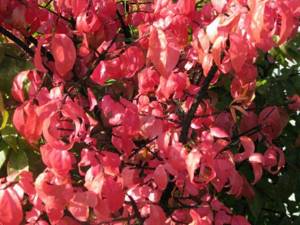
The leaves are ovate or inversely ovoid in shape, the length of the leaf can reach 11 cm. By autumn they begin to turn red. The color of the fruit is pink or red.

Types of Euonymus for a summer cottage
Euonymuses are evergreen and deciduous. Flowers of more than 5-6 inflorescences appear on them, forming a beautiful “tassel”. The fruit of the plant is a four-parted capsule with seeds inside.
Euonymus can have different shades. Yellow, pink, crimson and scarlet, burgundy tones are known.
There are about 200 species of euonymus. More than 25 varieties grow in Russia. The plant is considered poisonous, although it has some medicinal functions. Each subspecies has separate requirements for planting and care, and they are also described by specific characteristics.
The variety comes from Eurasia. The height reaches up to 6 m. It blooms in early summer. The fruits are red.
It is distinguished by green, rounded tetrahedral processes; there are also longitudinal leaves closer to the root system. The ripe fruit is red in color. In late autumn, the inflorescences become red. The variety stands out for its excellent ability to live in shady areas.
It can have a height of up to 7 m. Growths appear on the shoots, which gives the plant a tetrahedral shape. In the garden, the European variety plant blooms in late spring. Fruit ripening continues until the end of summer. The plant's capsule is pale pink in color, and the seeds appear white or red. The appearance of black seeds is also possible. The variety is endowed with drought resistance.
- Evergreen shrub from Japan.
Plant height is up to 8 m. It has shoots with a tetrahedral cross-section. The leaves are oval, the flowers are green with white splashes.
- Fortune's euonymus comes from China.
The plant is a small evergreen bush 35 cm high. The lower branches of Fortune are covered with oval-shaped leaves with a special shine.
Fortune almost never produces inflorescences. The variety rarely bears fruit.
Top 5 plants for hedges
We have selected plants for hedges that are in greatest demand. These are Thunberg barberry, euonymus, thuja, spirea, hawthorn.
Let's look at each one separately.
Thunberg's barberry (Berberis thunbergii)

This shrub is very attractive for creating a living fence. A medium-sized plant with a spherical bush shape. The height of this type of barberry can reach up to 2.5 m. It blooms in May. Fruits in September - October. Thunberg barberry is valued for its sharp thorns, so such a fence will be an excellent guard for a suburban area. However, this is not the only remarkable quality of this shrub. Barberry is resistant to frost and cold.
With the help of this shrub they form wonderful fences. The leaves of Barberry Thunberg turn bright red or yellow in autumn, creating a stunning display in the country garden. This shrub will grow well on fertile soils. Barberry is sensitive to lack of moisture. If the summer is dry, watering is required. The shrub feels good both in sunny areas and in partial shade. It needs to be trimmed 2 times a year.
Euonymus (Euonymus)
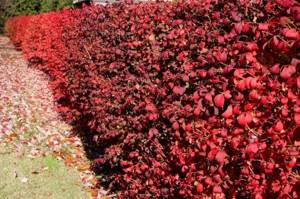
The owner of a dense and beautiful crown. The graceful branches of the euonymus are decorated with multi-colored leaves, however, in the summer the leaves are dark green. Great for creating picturesque hedges. It reaches a height of about a meter and a width of 2-3 meters. Tolerates cold winter well. Loves fertile soils. Pruning is done in early spring. It prefers to grow in well-lit areas, but also does well in partial shade.
Thuja
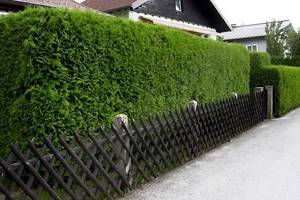
Thuja is excellent for an evergreen fence. There are a large number of different varieties. They can be low or tall, and without trimming they can reach up to 12 meters in height. The winter hardiness of this plant is not bad, but the variety must be taken into account. On moist soils, thuja produces a denser crown. This evergreen plant grows well in both sun and partial shade and loves spraying.
Hawthorn

This shrub makes excellent hedges as it has beautiful foliage and colorful fruit. Hawthorn fruits are also useful. It also has many thorns and is frost-resistant. It can reach a height of up to 7 meters, it depends on the species. The shrub loves places with good light and heavy, well-drained soil. Unpretentious to water.
Spiraea

A very beautiful, graceful and delicate shrub with white flowers. The height can reach two meters. Winter-hardy, prefers moist soils, but responds normally to drought. Loves sunny places and partial shade.
Specifics and varieties of Fortune's euonymus
This species can grow even at low temperatures - down to -25 degrees. A large number of branches, which protect the root system from frost and cold, allows it to survive harsh conditions.
Fortune has 4cm leaves with slightly curved ends. The color of the leaves is different, they include:
- Green with white edges in summer, pink in winter.
- Dark green all year round.
- Green with yellow splashes all year round.
- Green with yellow edges, in winter - with pinkish edges.
- In winter, with a crimson color.
The planting has a characteristic glossy coating on the leaves.
Beautiful euonymus Fortune - planting and care in the garden
The planting rules are simple, but the following conditions must be met:
- The plant has a bright color and to plant it you need to choose a lighted place or an area with predominant daylight. Lack of natural light can lead to loss of beautiful leaf color.
- It is not recommended to plant Fortune in places with holes and deep ditches, where there is a possibility of natural water accumulation. Excess moisture can cause fungal infections of the root system.
- The soil for planting should be chosen with a crumbly texture. If the area where you intend to plant the shrub has a clay surface, it is recommended to add sand or humus from leaves to it. When the soil becomes acidic, chalk is added 7 days before planting. Mix the consistency well.
- You need to add compost to the hole for growing Fortune.
- The plant should be mulched with sawdust from deciduous trees or hay.
You cannot use the bark of conifers for this purpose to avoid increasing the acidity of the soil.
Euonymus Fortune requires light substrates for normal growth. However, the plant adapts well to soils with low alkalinity. After planting, you should carefully care for the shrub.
- It is not recommended to water a mature planting frequently. Newly planted plants should be additionally watered.
- In spring, the surface near Fortune needs to be loosened, but carefully so as not to injure the root system, which is located at a shallow depth.
- It is recommended to fertilize Fortune once every 2 years with mineral mixtures and green manure. The optimal period for this is considered to be March-April.
The planting grows quite slowly. Over the course of a year, the branches can increase by 10 cm. It can be easily decorated.
Fortune's euonymus can be affected by:
- Aphids. Insecticides are used against them.
- Spider mite. To combat it, the bush is treated with acaricides. The processing procedure is carried out in dry weather.
Basically, in this species, only damaged shoots or branches that disrupt the ideal appearance of the shrub are pruned.
Rules for propagating shrubs by cuttings
In July and August, separate the young shoots from the bush and divide them into segments , the length of each of which will be from 6 to 9 cm. In order for the cuttings to take root faster, place them in a solution of a growth stimulator - Heteroauxin for 10 hours. Then plant the future plants obliquely in a wooden box and cover with cling film.
You can prepare the soil for cuttings with your own hands by mixing leaf soil and sand. So, provided the air temperature is at room temperature and the substrate is moderately moistened, the cuttings will acquire a root system in the fall. And also in October or November, you can cut lignified cuttings from the main part of the shoots using a similar technology and plant them under cover on the street. Their intensive growth will begin in the spring with the arrival of warmth. Practice shows that the winged euonymus reproduces best in this way, while the European and warty ones reproduce worse.
Also read: Rhododendrons: description of species, features of planting and care in the Moscow region, Siberia, Ukraine and the Urals
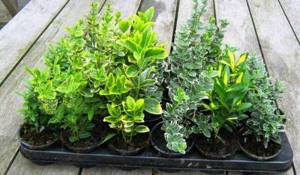
Intensive growth of euonymus cuttings will begin in the spring with the arrival of warmth
Application for landscape decoration
This type of plant is indispensable for decorating the landscape of the middle zone:
- This evergreen shrub, covered in winter, pleases the eye with bright and saturated colors when the snow cover disappears.
- The plant can be trimmed, and Fortune will keep its shape perfectly.
- In autumn, the bush is decorated with beautiful earrings of inedible berries.
The beautiful planting is distinguished by a small characteristic. It can grow upward along the wall, enveloping it with its branches. In order to prevent slipping from a smooth surface, supports are built under them.
Plantings are used to decorate verandas, terraces, summer kitchens and pergolas. In the photo, Fortune's euonymus is combined with other plantings in landscape design. It is often decorated to create a single composition.
Fortune's euonymus (Euonymus fortunei)

Today, Fortune's euonymus is at the peak of popularity, the reason for which is not only the pronounced decorativeness of the plants, but also their diversity and endurance. This is a rare variety of euonymus that remains evergreen and survives Russian winters. In addition to the traditional form of the plant with lanceolate leaves and small white-red fruits, as in the photo of the euonymus, there are numerous creeping varieties. It is they who are of interest to Russian lovers of ornamental crops.
The flowers are small greenish-white, the fruit-pods are also smaller than those of other species. They are flattened-spherical in shape and wingless. In the middle zone and to the north, only creeping forms are stable.
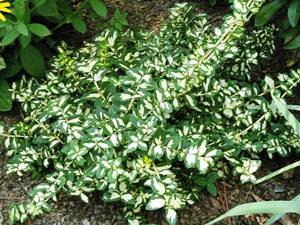
For example, a variety of euonymus fortunei var. radicans is a fast-rooting, climbing or trailing small shrub suitable for planting as a border or ground cover.
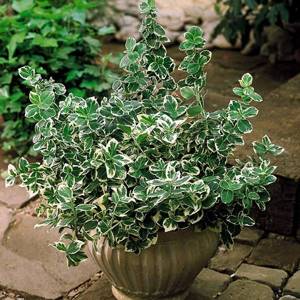
The fortune euonymus variety Emerald Gaiety, with a height of only 30 cm, simply cannot be ignored due to its bright oval foliage with a contrasting white edge. This color is typical for summer; by autumn, the evergreen euonymus turns pink-purple.
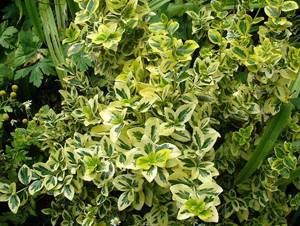
The spectacular and very unassuming euonymus fortunea Emerald Gold is another variegated variety, but with yellow-green foliage. The maximum height of plants does not exceed 50 cm, but tenacious shoots actively grow and form a crown up to one and a half meters wide.
Fortune's euonymus Harlequin is even more decorative than previous varieties of this amazing plant. Its young foliage is almost white. Greenery is present on it in the form of small chaotic spots. Only as it grows older does it acquire a more traditional color, but the light border still remains.
Small-leaved euonymus Fortune Minimus is one of the smallest and most graceful varieties. Its height is only 15 cm, but it is impossible to pass by it. Bright rounded leaves attract the eye both in summer and winter.
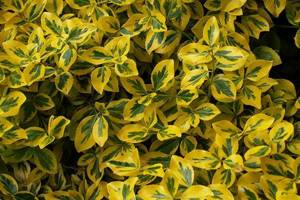
In the spectacular variety of euonymus Sunshine, yellow is the main color of the small oval-pointed foliage. The plant holds its shape perfectly, can be shaped and will become an original decoration for a living border, flower bed or alpine slide.
Video about euonymus
Gardeners undeservedly forget about euonymus - a picturesque plant that can transform any garden plot. The advantage of this unpretentious culture is that it does not lose its attractiveness throughout the season. And by autumn, when the rest of the garden plunges into dull colors, the decorativeness of the euonymus only increases.
Euonymus
